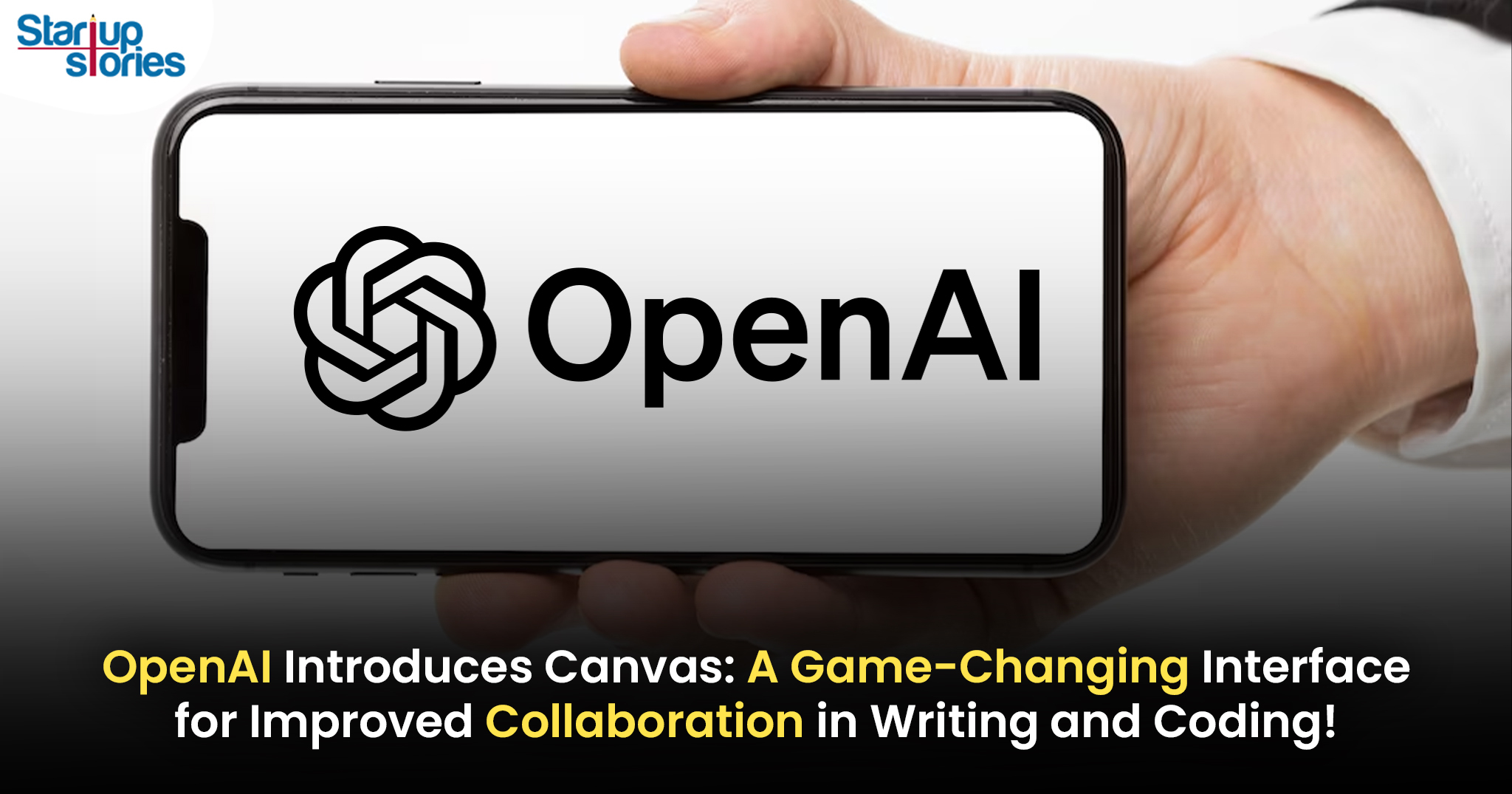Latest News
OpenAI Launches Canvas: A Revolutionary Interface for Enhanced Collaboration in Writing and Coding!

OpenAI has recently unveiled Canvas, a new interface designed to enhance the user experience for writing and coding projects within ChatGPT. This innovative feature, currently in early beta, represents the most significant visual redesign of ChatGPT since its launch two years ago. By facilitating more effective collaboration between users and the AI, Canvas aims to streamline the process of content creation and refinement.
Overview of Canvas
Canvas operates in a separate window alongside the traditional chat interface, providing users with a dedicated workspace to engage with ChatGPT on more complex tasks. This setup allows for a more interactive and collaborative approach, enabling users to generate text or code directly within the Canvas environment. Users can highlight specific sections of their work, prompting ChatGPT to make edits or provide tailored suggestions.
Key Features
- Collaborative Editing: Canvas allows users to work side by side with ChatGPT, making it easier to refine ideas and implement changes without losing context. Users can directly edit text or code and utilize a menu of shortcuts for various tasks, such as adjusting writing length or debugging code.
- Enhanced Context Understanding: Built on OpenAI’s GPT-4o model, Canvas is designed to understand broader contexts, enabling it to offer more relevant feedback and suggestions. For instance, if a user highlights a section of text and requests a specific change, ChatGPT can respond with targeted edits or even rewrite entire passages based on user input.
- Real-Time Feedback: For writing tasks, Canvas provides real-time feedback on grammar, clarity, and structure. Users can ask ChatGPT to suggest edits or change the tone of their writing, such as making it friendlier or adding emojis for emphasis.
- Coding Support: For developers, Canvas offers specialized features like adding comments to code, fixing bugs, and translating code into different programming languages. Users can highlight sections of code to receive explanations or ask for revisions, making it easier to track changes and understand complex coding tasks.
Availability
As of October 3, 2024, Canvas has been rolled out globally to ChatGPT Plus and Team users. Users in the Enterprise and Education sectors will gain access shortly thereafter. OpenAI plans to extend availability to all free users once the feature exits its beta phase.
Implications for Users
The introduction of Canvas reflects a growing trend among AI providers towards creating editable workspaces that facilitate more natural interactions between users and AI systems. Daniel Levine, an OpenAI product manager, emphasized that this interface allows for a more intuitive collaboration process compared to traditional chat interactions.
The ability to make iterative changes in real time is particularly beneficial for both writers and coders who often require multiple revisions before finalizing their work. By streamlining this process, Canvas aims to enhance productivity and creativity among its users.
Conclusion
The launch of Canvas marks a significant advancement in how users interact with ChatGPT for writing and coding projects. By providing a dedicated workspace that supports collaborative editing and contextual understanding, OpenAI positions Canvas as a valuable tool for enhancing productivity in creative endeavors. As this feature continues to evolve through user feedback during its beta phase, it promises to become an essential resource for anyone looking to leverage AI in their writing and coding tasks.
With these enhancements, OpenAI is not only improving the functionality of ChatGPT but also setting a new standard for AI-assisted collaboration in creative fields. As users adapt to this new interface, they can expect a more seamless experience that fosters innovation and efficiency in their projects.
Latest News
Kuku FM’s $200 Million IPO: Mebigo Labs Hires Top Bankers to Lead Public Listing

Kuku FM’s parent company, Mebigo Labs, has hired leading investment banks to prepare for a 200 million dollar IPO in India, marking a major milestone for the country’s digital audio ecosystem. The Mumbai-based company has reportedly appointed Kotak Mahindra Capital, Axis Bank and Morgan Stanley’s India unit to manage the proposed share sale, which is likely to be launched on Indian stock exchanges once key regulatory steps are completed. This move signals strong intent to tap public markets and test investor appetite for subscription-led regional audio platforms in India.
The planned IPO proceeds are expected to help Kuku FM expand its content library, strengthen its regional language offerings and invest in technology to enhance user experience. With a focus on Hindi, Marathi, Tamil and other Indian languages, Kuku FM aims to capture the fast-growing audience in Tier 2 and Tier 3 cities seeking affordable audiobooks, courses and storytelling content. The funds could also provide additional firepower for marketing, partnerships and product innovation, helping the platform compete more aggressively in India’s crowded digital entertainment and creator economy landscape.
Founded in 2018, Kuku FM has built a subscription-driven business model and has reportedly scaled to millions of paying users, backed by multiple funding rounds from prominent investors. Its decision to pursue a 200 million dollar IPO positions it as one of the first major Indian audio platforms to attempt a public listing, potentially paving the way for other podcast and niche content startups to follow. As the IPO process moves forward, Kuku FM’s performance in the public markets will be closely watched as a key indicator of how investors value regional, knowledge-first audio platforms in India’s booming digital economy.
Latest News
Zerodha Reports 23% Profit Decline in FY25 as Revenues Miss Target

Zerodha experienced a challenging FY25, as its revenue fell 11.5% to ₹8,847 crore and net profit dropped 22.9% to ₹4,237 crore. This decline reflects tougher regulatory conditions, lower trading volumes, and increased operational costs in the brokerage market, all of which impacted core earning segments for the company.
Despite these headwinds, Zerodha improved its operating margin to 63.78% and built up significant cash reserves, reporting ₹22,679 crore in bank balances. Salary expenses and director remuneration increased, but disciplined cost controls helped the company maintain profitability and a debt-free balance sheet. The drop in active clients and increased compliance costs further contributed to the profit contraction.
Looking ahead, Zerodha’s resilience is supported by its robust cash position and operational efficiency. Maintaining steady margins, diversifying product offerings, and investing in technology positions the company to withstand future regulatory fluctuations and changing market sentiment reinforcing its status as one of India’s leading brokerage firms.
Latest News
Zoho Pay Debuts as India’s New UPI Challenger, Taking on PhonePe, Paytm, and Google Pay

Zoho Corporation has expanded its fintech portfolio with the launch of Zoho Pay, a UPI-based payments app built to challenge India’s top digital payment giants such as PhonePe, Paytm, and Google Pay. The new app supports peer-to-peer transfers, bill payments, QR-based transactions, and merchant settlements in a streamlined interface. Available as both a standalone app and an integrated feature inside Zoho’s privacy-driven messenger Arattai, Zoho Pay enables users to handle chats and payments in one platform, emphasizing data privacy and Made-in-India innovation.
Through seamless integration with Arattai, Zoho Pay allows users to send or request payments, split expenses, and conduct UPI-based transactions directly in their chat windows. Users can link bank accounts, scan dynamic QR codes, and receive audio confirmations of payments, ensuring speed and security. This design mirrors the simplicity of India’s leading UPI apps but is powered by Zoho’s non-advertising, privacy-first model. The integration aligns with Zoho’s mission to build a self-reliant digital ecosystem, where messaging and money management coexist securely.
In the competitive digital payments market, Zoho Pay differentiates itself through its tight business software integration with apps like Zoho Books, Zoho Payroll, and Zoho Commerce, offering small businesses unified access to payments, billing, and accounting. The company is also expanding its reach with POS devices for merchants featuring UPI QR, card payments, and instant reconciliation tools. With founder Sridhar Vembu’s vision of a ‘Chat + Pay’ ecosystem, Zoho Pay reflects a bold step toward redefining India’s fintech scene with a secure, ad-free, and locally developed alternative to global payment platforms.










best binance referral code
March 13, 2025 at 3:15 am
Thank you for your sharing. I am worried that I lack creative ideas. It is your article that makes me full of hope. Thank you. But, I have a question, can you help me?
qwvf6
June 7, 2025 at 5:18 pm
can i purchase clomiphene prices cost of generic clomiphene get cheap clomid without rx can i get clomiphene for sale where buy cheap clomiphene can you get clomiphene without rx order cheap clomid no prescription
javmax.cc
June 8, 2025 at 8:09 am
certainly luke your website butt yoou need tto test the spelling on quite a few off your
posts. Several off them are riufe with spellibg problems
andd I tto fiind it verdy bothwrsome too inform the realikty however I wil definitely ckme atain again.
注册Binance
August 18, 2025 at 12:45 pm
Thanks for sharing. I read many of your blog posts, cool, your blog is very good.
binance
September 23, 2025 at 4:44 am
Thanks for sharing. I read many of your blog posts, cool, your blog is very good.
MM88
November 10, 2025 at 10:58 pm
Với giao diện mượt mà và ưu đãi hấp dẫn, MM88 là lựa chọn lý tưởng cho các tín đồ giải trí trực tuyến.
站群程序
November 11, 2025 at 12:01 pm
采用高效谷歌站群策略,快速提升网站在搜索引擎中的可见性与权重。谷歌站群
J88
November 14, 2025 at 1:08 am
Đến với J88, bạn sẽ được trải nghiệm dịch vụ cá cược chuyên nghiệp cùng hàng ngàn sự kiện khuyến mãi độc quyền.
Kuwin
November 15, 2025 at 7:53 am
kuwin sở hữu kho game đa dạng từ slot đến trò chơi bài đổi thưởng, mang đến cho bạn những giây phút giải trí tuyệt vời.
binance kod
November 15, 2025 at 1:54 pm
Thanks for sharing. I read many of your blog posts, cool, your blog is very good.
MM88
November 16, 2025 at 11:28 pm
Khám phá thế giới giải trí trực tuyến đỉnh cao tại MM88, nơi mang đến những trải nghiệm cá cược thể thao và casino sống động.
GO88
November 30, 2025 at 2:57 pm
Tham gia cộng đồng game thủ tại Go88 để trải nghiệm các trò chơi bài, poker phổ biến nhất hiện nay.
iwin
December 1, 2025 at 12:49 am
iwin – nền tảng game bài đổi thưởng uy tín, nơi bạn có thể thử vận may và tận hưởng nhiều tựa game hấp